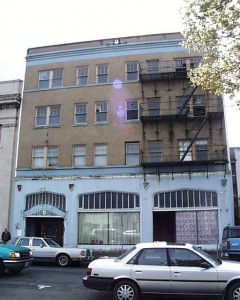 Demolishing historic buildings is always a battle. In Astoria, the Merwyn Hotel (now called the Waldorf) was saved from demolition by a recent ruling the Historic Landmark Commission, which found that removing the building without any replacement in mind did not demolition standards. The building has not been used for 25 years and has had a checkered life since then. A non-profit tried to make it into low income housing and got in over their heads. They left the building worse than they received it and the City stepped in to stabilize the building and fix the roof. While the concrete shell is intact, the wood crib walls in the light courts and some of the wood beams have serious rot problems. Ownership of the property has been problematic, with the building eventually put in the hands of the Clatsop Housing Authority who then backed out another effort for low income housing. They then traded the property as part of deal to acquire a low income housing complex in Seaside. The new owners sat on the property and the solution for what to do has devolved into selling it to a demolition company. This company approached the City to say they would demolish the building and then sell the empty lot to the City for a good price.
Demolishing historic buildings is always a battle. In Astoria, the Merwyn Hotel (now called the Waldorf) was saved from demolition by a recent ruling the Historic Landmark Commission, which found that removing the building without any replacement in mind did not demolition standards. The building has not been used for 25 years and has had a checkered life since then. A non-profit tried to make it into low income housing and got in over their heads. They left the building worse than they received it and the City stepped in to stabilize the building and fix the roof. While the concrete shell is intact, the wood crib walls in the light courts and some of the wood beams have serious rot problems. Ownership of the property has been problematic, with the building eventually put in the hands of the Clatsop Housing Authority who then backed out another effort for low income housing. They then traded the property as part of deal to acquire a low income housing complex in Seaside. The new owners sat on the property and the solution for what to do has devolved into selling it to a demolition company. This company approached the City to say they would demolish the building and then sell the empty lot to the City for a good price.
 The property sits between City Hall and the public library so one could image a public use. However, the City Hall was just renovated and it is unlikely it will expand. There has been talk for years about a new library, but there are no plans for expansion, and it is not clear if one is needed. The removal of the Merwyn would require bracing for both the City Hall and the Library to replace the lateral bracing the Merwyn was inadvertently providing, so bracing of some sort is needed wether the building stays or is demolished.
The property sits between City Hall and the public library so one could image a public use. However, the City Hall was just renovated and it is unlikely it will expand. There has been talk for years about a new library, but there are no plans for expansion, and it is not clear if one is needed. The removal of the Merwyn would require bracing for both the City Hall and the Library to replace the lateral bracing the Merwyn was inadvertently providing, so bracing of some sort is needed wether the building stays or is demolished.
The Historic Landmarks Commission made the right call. The historic district is more important than an individual building. The street facade, made of concrete with brick facing, is no danger to public safety. Since shoring is needed whether the building is torn down or not, better to stabilize it until the plans for the building are in place. The challenges for restoring or reusing the building are many, but Astoria has examples of equally unlikely restorations of other buildings. If, in the end, a new building is the only option, this will go through a design review process to make sure it is compatible with the historic district, which an empty lot would not be.
Whatever the outcome, there is a strong system of review in Astoria to deal with historic buildings. Such is not the case in Phoenix where the David and Gladys Wright house is at imminent risk of demolition. This historic house has no protections other than its reputation as one of Wrights 20 most significant buildings. Preservationists are trying to convince the City of Phoenix to list the building, which they are reluctant to do since the owner is not willing. It should be noted, that this would not be an option in Oregon, since Oregon law prevents listing of unwilling owners. Once listed, you do get some protection, it is hoped that the City of Phoenix will do the right thing.
 To demolish or not, to preserve for a while longer, or to preserve into the future. These are questions that arise with many historic buildings. The Merwyn is more important as a background building, built in the 1920’s after the fire, as so many of Astoria’s downtown buildings. It is truly the historic district that is important and saving the pieces helps save the whole. The David an Gladys Wright is an important individual building, part of Wrights Usonian period, and done for his son so that there is a personal attachment there as well. Its loss won’t diminish its neighbors, but it diminish our American culture as a whole, since Wright played such a pivotal roll in American architecture and is still probably the best known of American architects even now.
To demolish or not, to preserve for a while longer, or to preserve into the future. These are questions that arise with many historic buildings. The Merwyn is more important as a background building, built in the 1920’s after the fire, as so many of Astoria’s downtown buildings. It is truly the historic district that is important and saving the pieces helps save the whole. The David an Gladys Wright is an important individual building, part of Wrights Usonian period, and done for his son so that there is a personal attachment there as well. Its loss won’t diminish its neighbors, but it diminish our American culture as a whole, since Wright played such a pivotal roll in American architecture and is still probably the best known of American architects even now.


Comments
One response to “Demolitions”
Glad I found your post. It was Very helpful indeed. I am going to share it on my blog and link here if that is ok.